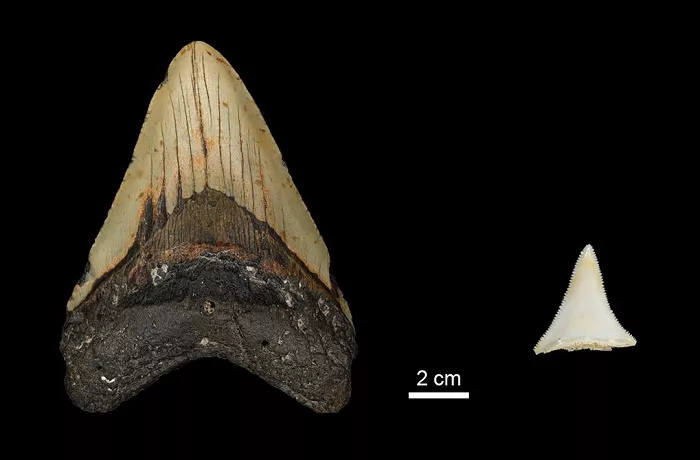A team from the Max Planck Institute of evolutionary anthropology has just introduced a new clue to "compete with great white sharks or cause the extinction of giant toothed sharks" Jeremy McCormack, the research leader, pointed out that as the largest shark in history, the ododus MEGALODON lived in the earth's oceans 23 to 3.6 million years ago.

Comparison of tooth size between the early Pliocene megatoothed shark and the modern great white shark (from MPI / Evolutionary Anthropology)
It is reported that the giant toothed shark can reach a length of 20 meters (65 feet) and weighs 103 tons. It can definitely be ranked in the list of "the strongest predators in history". In contrast, the modern great white shark is only 6 meters (20 feet) long and weighs about 2268 kilograms (5000 pounds).
However, the recent new research on the zinc isotopes in the teeth of two shark species has given us a deeper insight into the predatory habits of ancient sharks - it is speculated that both were preying on very similar prey.
Isotope analysis is a powerful tool to understand biological habits, because the ratio difference between one element and another element can help scientists trace their food sources, eating habits and their position in the food chain.
At the same time, MPI researchers also hope to infer how much predatory competition has played in the process of the species' enlargement and extinction.
Usually, researchers will study the isotope ratio from the aspect of organic matter, especially the nitrogen isotope of protein in bone.
The problem is that sharks belong to a branch of the ancient cartilaginous fish. They were separated from the evolution path of bony fish hundreds of millions of years ago, so there is very little bone material in their bodies.

Study 1: Jeremy McCormack's use of zinc in separating shark tooth samples
The protagonist of this article is a typical case of giant toothed shark. Although it has been widely known in the past half century and has acted in many film and television works, the only evidence of its existence is only teeth and some vertebral fragments.
To make matters worse, these fossils are millions of years old, so any organic matter has long been replaced by minerals or degraded to a degree difficult to analyze.
In view of this, the MPI research team chose to collect isotopes from modern / FOSSIL SHARK TOOTH samples around the world, especially the highly mineralized enamel, to replace the collagen in the living dentin.
By observing the shark teeth of the early Miocene (204 ~ 16million years ago) and the early Miocene (53 ~ 3.6 million years ago), and then comparing them with modern sharks, the research team reached the following conclusions:
First of all, the zinc isotope measurements of modern and ancient sharks are almost the same, indicating that there is a high coincidence between the two.
Secondly, megatoothed sharks should also be at the top of the food chain, and prey on the same type of prey as great white sharks.
Michael Griffiths, a professor at William Paterson University, said: "our results show that the megatoothed shark and its ancestors are indeed top predators, and they are both high in their respective food chains.".
However, it is worth noting that the zinc isotope values of shark teeth from the early Pliocene in North Carolina show that the nutritional level of the early great white shark overlaps with that of the larger giant toothed shark to a large extent.
It is speculated that the great white shark may have been competing for food with the megatoothed shark, which led to the decline of the latter in the early Pliocene. As for the exact nature of the game, further research is still needed to reveal.
Another guess is that the two species may forage on the same territory in different seasons.
In conclusion, Jeremy McCormack believes that it is indeed quite feasible to use the zinc isotope method to study the diet and nutritional ecology of animals extinct in the past millions of years.
We can even use the same method to trace the fossils of human ancestors and other animal populations.